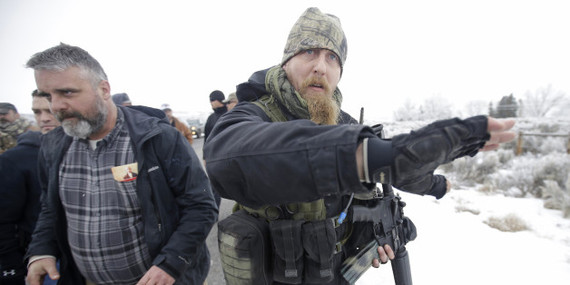The armed seizure of Malheur National Wildlife Refuge in southeast Oregon began on January 2 with the arrival of a small sad band of would-be insurrectionists, most from outside of Oregon. Sporting some camouflage get-ups, they brandished a considerable cache of firearms to be used against attempts to remove them, and they regurgitated long-debated complaints about the ownership and management of land by federal and state governments in the rural western U.S.
The occupation continues, albeit sputtering, after the arrests last week of several of its leaders, including a principal organizer, Ammon Bundy of Nevada, and the shooting death of one occupier by Oregon State Police officers during a roadside confrontation.
A video made by the FBI from a plane flying above the encounter -- enhanced with slow-motion magnification by the Portland Oregonian newspaper -- shows a person attempting to drive his vehicle around a roadblock, exiting his vehicle when it gets stuck in snow, and then alternating between raising his arms in seeming surrender and thrusting his right hand inside his jacket at least three times. At that point, Oregon State Police troopers shot and killed him. The FBI said it recovered a loaded handgun from an inner pocket of the dead man's jacket.
Since the confrontation, the jailed Bundy has sent word twice through his lawyer that anyone from his group who was still on refuge property should go home, but not everyone has taken his advice. Some remaining occupiers have offered to leave but insist that they and those previously arrested must first receive full pardons for any state and federal crimes they have committed.
Good luck with that plan. As of Wednesday, 16 militants, including the four remaining occupiers, face federal grand jury indictments on felony conspiracy charges.
One armed man still at the refuge
appeared in a YouTube video after the roadside shooting, invoking armed resistance and screaming about an impending Armageddon.
Besides the birds, mammals, fish, insects and diverse plant life of the Malheur National Wildlife Refuge, a regular stopping point along the Pacific Flyway migration route, Oregon's Harney County is home to 7,146 men, women and children. They are widely scattered in and around the county's 6.5 million acres of open land, small towns, ranches and two-lane roads and highways. That averages out to about one person for every 900-1,000 acres.
Of the residents who have expressed opinions to news outlets, most have strongly opposed the occupation from the start, even those who say they have concerns about government land practices. Some have said they've felt terrified by the extremists' unpredictable and intimidating presence and, on occasion, harassed by them.
In driving to Oregon and taking over by threat of violence an essentially undefended outpost in the middle of a beautiful nowhere, the extremists forced the closing of the refuge,  preventing its dozen and a half employees from performing what is not exactly a freedom-killing mission: Preserve, protect and, as necessary, restore the animal and habitat resources of Malheur National Wildlife Refuge for the benefit of all, including the 100,000 people or so from this country and abroad who visit each year, gun-toting hunters and rod-wielding anglers among them.
preventing its dozen and a half employees from performing what is not exactly a freedom-killing mission: Preserve, protect and, as necessary, restore the animal and habitat resources of Malheur National Wildlife Refuge for the benefit of all, including the 100,000 people or so from this country and abroad who visit each year, gun-toting hunters and rod-wielding anglers among them.
On Jan. 19, the staff members responded with an open letter posted to the refuge's Facebook page:
In a community with nearly 40 percent of working adults engaged in some form of government, we are all touched or involved in the public process. In Harney County, that means we talk. We have cups of coffee. We have arguments. Together we knit our brows, and together we knit scarves. We understand what those currently occupying the Refuge don't understand -- that Harney County isn't afraid of tough talk.
We can have effective disagreements and either find resolution, find compromise, or simply agree to disagree. But we do it with respect for the rule of law, and know that our areas of agreement and cooperation are infinitely more powerful than the differences we may face. Mostly, we face those differences together with open dialogue and open gates -- not intimidation and threats.
Until the arrests last week, law enforcement agencies had been letting the occupiers -- and curious visitors and reporters -- come and go pretty much at will. Not anymore. Multiple checkpoints on the roads serving the refuge buildings preclude unhampered access.
But about 10 days into the incident, an Oregon parent who lived a few hours away thought the occupiers' actions offered an educational opportunity and drove to the refuge with his 9-year-old daughter. "Something I want to teach her," the father told the New York Times, "is to not make decisions based on what's easy or what's comfortable, but to decide for herself what's right.... And that's what these guys are doing."
It seems to me the anti-government occupiers are doing just the opposite: They opted for threats of violence backed by a flashy display of thick-headed muscle that easily whipped up media coverage but was guaranteed to produce tragedy, as it did last week in the roadside confrontation.
The alternative would be a lot harder to pull off:
Because most Americans value government's responsibility to preserve our natural treasures and protect public land, air and water from ruin, the extremists first would need to make a clear and convincing case that government land ownership and management in the West is a serious problem. If successful, they could use their increased public support to pressure elected and appointed officials to take action and help elect others who share those views. Then they could forge coalitions, work to craft meaningful legislative and administrative reform proposals and follow through with pressure and persuasion to get the proposals adopted.
The occupation of Malheur (coincidentally a French word for "misadventure," "misfortune," "bad luck," "trouble" or "grief") has not produced even the tiniest indication of such steps. Rather, the show of arms and vows of violence have further marginalized and discredited the occupiers and their cause.
Standing in sharp contrast to the Malheur extremists are, for example, the years-long struggles of the civil and gay rights movements, built on civil disobedience, the manifold challenges of political organizing, pressure strategies and a steadfast adherence to non-violence. Other, more immediate, examples abound.
Devon Anderson, the district attorney of Harris County, Texas, which includes Houston, is one of them.
Last August, the pro-life Republican launched a criminal investigation into Planned Parenthood Gulf Coast (PPGC), the independent local affiliate of Planned Parenthood Federation of America. Members of an anti-abortion group, masquerading as representatives of a biotechnology firm, had secretly made and released video recordings of conversations with staff members of PPGC and other Planned Parenthood affiliates in different parts of the country.
The anti-abortion group said the recordings showed PPGC seeking to illegally profit from the sale of fetal tissue derived from women who had had abortion procedures at its health clinics. That provoked Anderson's investigation, and videos made in other cities resulted in investigations of Planned Parenthood by state and local agencies elsewhere, as well as by committees of the U.S. Congress.
Anderson brought impeccable pro-life credentials to her investigation. In the closing weeks of her 2014 election campaign, she was endorsed by the Texas Right to Life political action committee, and she was appreciative -- thanking the group on her campaign's Facebook page. "As a proud, pro-life Texan and mother of two," she posted on Oct. 20, 2014, "I am honored to be endorsed by Texas Right to Life PAC. I will always take a stand for those who cannot yet defend themselves."
Last week, Anderson announced the results of a Houston grand jury examination of the evidence gathered in the investigation. The grand jury declined to indict PPGC or any of its people. Instead, it indicted two members of the anti-abortion group that made the videos on felony and misdemeanor charges relating to the creation of counterfeit identification documents and a false corporate registration filing. The seemingly damning videos, meanwhile, turned out to have been doctored and heavily edited.
Investigations in Indiana, Pennsylvania, Georgia, Massachusetts, Missouri, South Dakota, Kansas and Congress similarly concluded there was no evidence of unlawful conduct by Planned Parenthood.
Deep in the heart of Texas, however, Anderson was hammered by elements of the pro-life movement.
Anderson's response was a brief video statement of her own that dispelled with facts the misinformation in some of the criticisms and made a simple declaration of principle: "The inconvenient truth of a criminal investigation is that it doesn't always lead where you want to go," she said. "I believe abortion is wrong. But my personal belief does not relieve me of my obligation to follow the law."

